AUSTIN, Texas — Researchers at the University of Texas at Austin are learning more about the “grue jay,” a hybrid between a blue jay and green jay, discovered in a San Antonio suburb.
The bird was discovered back in 2023 and later reappeared in the same yard two years later in a Universal City neighborhood. Donna Currey captured the first glimpse of the bird.
Currey says she isn’t much of an avid birdwatcher — but her keen eye noticed something off about the jay.
“I was sitting here having my coffee, and I’m looking out over at the bird feeder, and there’s this bird,” she said. “It’s a blue jay, but it’s not a regular blue jay because it had a black head.”
The Air Force veteran took some pictures of Henry (her personal name for the grue jay) and posted them on Facebook, where bird groups took notice and flew it up to Brian Stokes, a PhD candidate at UT Austin.
Stokes studies ecology, evolution and behavior, with part of his focus being on the impact of climate change and land use on green jays. He headed down to Currey’s home to collect DNA samples.
“A chance encounter and some romance, and we ended up with the bird we found,” he said. One of the contributing factors is the slow rise in temperatures Central Texas is facing.
“Over time, these species that were historically not close together are now overlapping in their breeding ranges and have the potential to mate,” Stokes said. He explained that green jays, whose habitat used to cover Central America and barely into South Texas, have now moved north into San Antonio.
Blue jays also experienced a wider habitat area, with Houston often being the furthest west the birds would go. Warmer temperatures have led them to move even further west into the San Antonio area as well.
Despite leading to the discovery of the grue jay, there is also some concern.
“There’s all sorts of species that are becoming established in Texas,” Stokes said. “Some are probably harmless; some, like the green jay, might not be a huge deal if they move into your backyard. But maybe some insect-borne diseases or other disease vectors can be moving into our state as well.”
Stokes said he will continue to look for more sightings of grue jays.
Currey patiently awaits Henry’s return in the summer.
“I did buy some more raw peanuts. When June comes around, I’ll put those out, because he liked those. He’d eat them over there and eat them on that table there. He’d fly over and get his peanuts,” Currey said.

